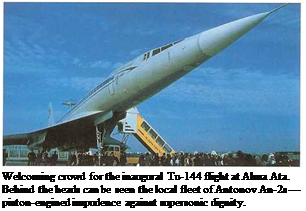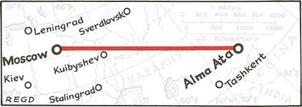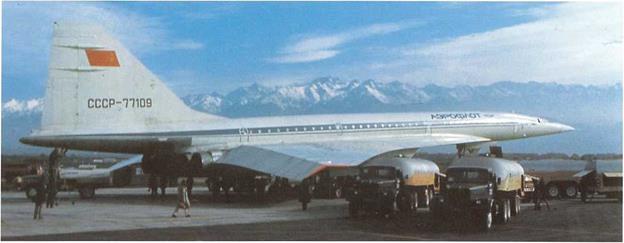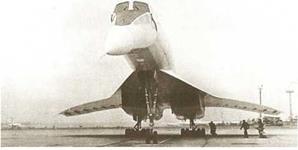Tupolev Tu-154
164 SEATS ■ 900km/h (580mph)
Kuznetzov NK-8-2 (3 x 9,500kg,20,9501b) ■ MTOW 90,000kg (198,4151b) ■ Normal Range 2,850km (l,770mi)
Unlikely Champion
For those interested in records, in terms of the greatest, the fastest, or the ‘mostest’, the Tupolev Tu-154 offers a fascinating exercise in statistics. The work output of the Aeroflot fleet of this type is arguably the most productive of any individual aircraft type by any individual airline in the world, measured by the standard method of calculation, based on the annual aggregate output of passenger miles.
This is not to suggest that the Tu-154 is therefore the most economical aircraft of any of its contemporary rivals. But in producing the aircraft and in operating it under the Soviet conditions of financial and operating criteria, the Tupolev Design Bureau and Aeroflot have served their country well. For offsetting the higher seat-mile costs is the excellent performance which includes the ability to take off and land at almost any reasonable airport, even those without paved runways.
THE TRIJETS COMPARED
|
First Flight Date |
First Service Date |
Aircraft Type |
Dimensions-m(ft) |
Speed km/h (mph) |
Seats |
MTOW kg (lb) |
Normal Range km (mi) |
First Airline |
No. Built |
|
|
Length |
Span |
|||||||||
|
9 Jan |
11 Mar |
DH |
35 |
29 |
930 |
84 |
59,000 |
1,900 |
B. E.A. |
117 |
|
1962 |
1964 |
Trident |
(115) |
(95) |
(580) |
(130,000) |
(1,200) |
|||
|
9 Feb |
1 Feb |
Boeing |
40 |
33 |
930 |
94 |
76,650 |
3,200 |
Eastern |
572 |
|
1963 |
1964 |
727-1 GO |
(133) |
(108) |
(580) |
(169,000) |
(2,000) |
|||
|
27 Jul |
14 Dec |
Boeing |
47 |
33 |
970 |
140 |
94,300 |
2,400 |
Northeast |
1,260 |
|
1967 |
1967 |
727-200 |
(153) |
(108) |
(605) |
(208,000) |
(1,500) |
|||
|
3 Oct |
9 Feb |
Tupolev |
48 |
38 |
900 |
164 |
90,000 |
2,850 |
Aeroflot |
1,000* |
|
1968 |
1972 |
Tu-154 |
(157) |
(123) |
(580) |
(198,415) |
(1,770) |
|||
|
Notes: |
Production continues. |
 (Right) Passengers disembark from the inaugural Tu-154 flight to Simferopol, main airport for the Crimean resort area. (Boris Vdovienko)
(Right) Passengers disembark from the inaugural Tu-154 flight to Simferopol, main airport for the Crimean resort area. (Boris Vdovienko)
Supersonic Diversion


![]()


Sharing The Dream
While many in the West tended to dismiss the Tupolev Tu – 144 supersonic airliner project as being a copy of the Anglo – French Concorde, with allegations of much industrial espionage worthy of James Bond himself, the two aircraft were developed and produced simultaneously. The Tu-144, as many have surmised, was not copied, and did not follow the Concorde. In fact, it was the first to fly, and it was the first to go into service, albeit for air cargo service only, almost as a series of proving flights before the passenger service.
The Tupolev Tu-144, with its extensive use of titanium structure, and its advanced aerodynamics, gained the respect of American engineers and designers as no other Soviet aircraft had ever done before. But the Soviet supersonic program gradually lost momentum as the engineers and operator (Aeroflot) came face to face with reality; and the dream of supersonic airline schedules across the length and breadth of the U. S.S. R. faded.
Success — and Tragedy
The Tupolev Tu-144 had its moment of glory. Test pilot E. V. Yelian made the maiden flight on 31 December 1968, a date said to have been a political imperative, to be ahead of the Concorde, which first flew two months later. Both aircraft attracted world-wide publicity but then came disaster and tragedy. At the Paris Air Show, on 3 June 1973, a Tupolev Tu – 144 disintegrated as it pulled out of a steep dive. At first thought to be structural failure, then pilot error, or a combination of both, later analysis has suggested that both pilot and aircraft could have been victims of enforced programming changes that jeopardized a well-disciplined demonstration routine. Whatever the reason, it was a shattering blow to the hopes and aspirations of the Soviet aircraft industry.
Curtailed Service Record
Nevertheless, production continued. At first wholly supportive of the SST, Bugayev, head of Aeroflot, faced formidable problems and the operation of the revolutionary aircraft
TU-144 PRODUCTION
seemed impracticable. The engines could not be programmed to operate at full efficiency in alternating subsonic and supersonic speeds; high fuel consumption inhibited long range operations; the sonic boom limited the operational scope; and the cabin noise level was unacceptably high.
Ultimately, the entry of the Tupolev Tu-144 into airline service was almost a token gesture. Cargo flights began from Moscow to Alma Ata on 26 December 1975; passenger flights on the same route began on 1 November 1977; and these continued intermittently for only a few months before the service ended on 1 June 1978, after 102 flights. The dream had ended.
|
(Above) The Tupolev Tu-144, nose drooped, ready to take off on the inaugural passenger service from Moscow to Alma Ata on 1 November 1977. (Boris Vdovienko) |











